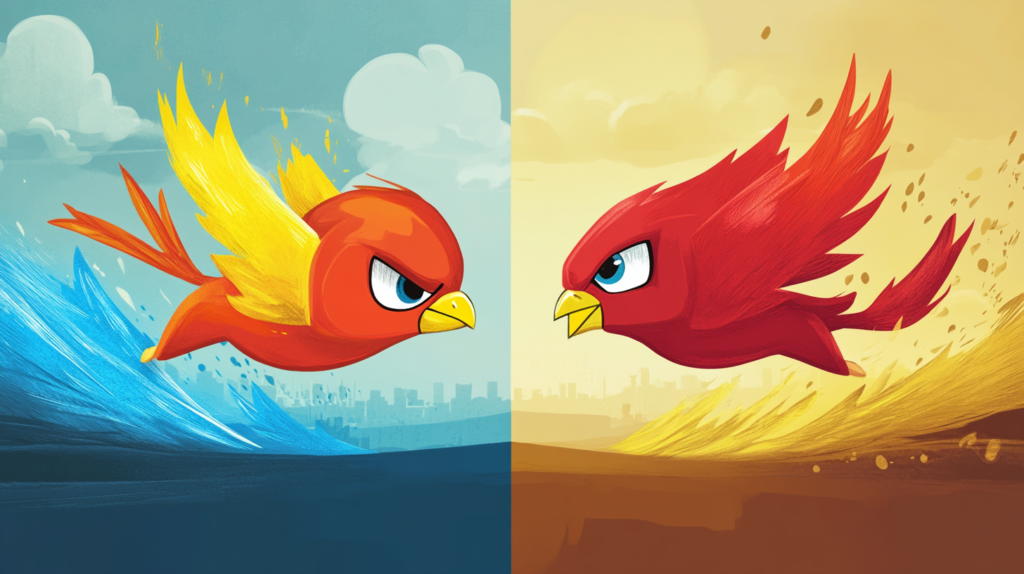In the world of digital animation, the transition from Flash animation to HTML5 animation has marked a significant shift in how artists and developers create, display, and interact with animated content on the web. As technology evolved, Flash, once a dominant tool for creating web animations, has gradually been replaced by HTML5, which offers more versatility and compatibility with modern web standards. As a cartoonist and animator, I’ve worked with both tools and experienced their pros and cons firsthand. This article explores the differences between Flash animation and HTML5 animation, examining their capabilities, limitations, and impact on the animation industry.
What Is Flash Animation?
Flash animation refers to animations created using Adobe Flash (formerly Macromedia Flash), a software platform that allowed artists to design and animate vector-based graphics. Flash was widely used in the late 1990s and early 2000s for creating interactive content, animated websites, games, and video players.
Key Features:
- Vector-Based Graphics: Flash uses vector graphics, allowing animations to scale without losing quality, making it ideal for web-based content.
- Interactive Elements: Flash supported interactive features such as buttons, clickable animations, and games, allowing for a more immersive user experience.
- Browser Plug-In: Flash required a browser plug-in (Adobe Flash Player) to display animations on websites, which became one of its major limitations over time.
Examples of Flash Animation:
- “Homestar Runner”: A popular web cartoon series that used Flash to create episodes with interactive elements.
- “Eddsworld”: An early example of Flash-animated web cartoons, showcasing how artists used Flash to create full-length animated content.
- Flash Games: Websites like Newgrounds and Miniclip were filled with Flash-based games that thrived during Flash’s heyday.

What Is HTML5 Animation?
HTML5 animation refers to animations created using the HTML5 standard, which includes features from CSS3 (Cascading Style Sheets), JavaScript, and the Canvas element to create interactive and dynamic web animations. HTML5 offers a more open and flexible alternative to Flash, as it does not require any external plug-ins and is supported natively by modern web browsers.
Key Features:
- Native Browser Support: HTML5 is built into modern web browsers, meaning users don’t need to download plug-ins to view animations, improving accessibility.
- Canvas and SVG Graphics: HTML5 supports both raster (Canvas) and vector (SVG) graphics, providing versatility in how animations are rendered.
- JavaScript and CSS3: These technologies allow for dynamic, responsive, and interactive animations that can adapt to various devices, including mobile phones and tablets.
Examples of HTML5 Animation:
- Interactive Web Content: Many modern websites use HTML5 to create engaging, interactive animations directly within the browser.
- Banner Ads and Motion Graphics: HTML5 is now commonly used for creating lightweight, animated banner ads that adapt to different screen sizes.
- Online Games: HTML5 has replaced Flash for many web-based games, offering more compatibility and better performance.

Key Differences Between Flash and HTML5 Animation
1. Compatibility and Accessibility
Flash Animation:
- Plug-In Dependency: Flash required the Adobe Flash Player plug-in to display animations in a browser, which led to widespread compatibility issues, particularly as mobile devices like smartphones and tablets gained popularity.
- Mobile Incompatibility: One of Flash’s major downfalls was its lack of support on mobile devices, especially after Apple announced it would not support Flash on its iOS devices, including iPhones and iPads. This decision accelerated Flash’s decline.
- Security Risks: Flash became notorious for security vulnerabilities, which led to many browsers disabling or blocking Flash content.
HTML5 Animation:
- Native Browser Support: HTML5 is supported natively by all modern browsers, including Chrome, Firefox, Safari, and Edge, making it accessible on both desktop and mobile devices without the need for additional software.
- Cross-Platform Compatibility: HTML5 animations run seamlessly on both desktop and mobile platforms, allowing for responsive design and a consistent user experience across devices.
- Better Performance: HTML5 animations tend to perform better than Flash, particularly on mobile devices, where power efficiency and speed are essential.
Personal Insight:
As someone who started animating during the peak of Flash’s popularity, I remember the frustration of needing to ensure viewers had the correct plug-in installed. HTML5 has made the process of sharing animations much smoother, especially when reaching mobile users.
2. Development and Animation Tools
Flash Animation:
- Integrated Development Environment (IDE): Adobe Flash provided a robust all-in-one platform for creating animations, combining a timeline-based animation tool with ActionScript (a scripting language) for interactivity.
- Timeline Animation: Flash’s timeline-based animation system allowed animators to easily create frame-by-frame animations or motion tweens, giving artists control over each frame’s movement.
- ActionScript: Flash’s scripting language, ActionScript, allowed for complex interactions, such as building interactive games, animated menus, and dynamic websites.
HTML5 Animation:
- Multiple Tools: Unlike Flash, HTML5 doesn’t have a single IDE. Instead, animators use various tools, such as Adobe Animate, Tumult Hype, or GreenSock Animation Platform (GSAP), along with coding in JavaScript and CSS to create animations.
- Canvas API and SVG: HTML5 provides the Canvas API for drawing and animating graphics on the fly using JavaScript, as well as SVG (Scalable Vector Graphics) for vector-based animations.
- No Single Timeline: HTML5’s animation process doesn’t follow the traditional timeline format of Flash, but rather uses JavaScript and CSS for motion control, often requiring more coding knowledge.
Personal Insight:
While Flash’s all-in-one environment was convenient, HTML5’s flexible toolset allows for greater creativity and adaptation. However, the lack of a unified timeline in HTML5 can make it feel less intuitive for artists who are more visually oriented and less comfortable with coding.
3. Performance and Flexibility
Flash Animation:
- Heavy Resource Use: Flash animations, especially those with high interactivity, often required significant CPU and memory resources, leading to performance issues, particularly on older or lower-powered devices.
- Poor Mobile Optimization: Flash’s performance on mobile devices was notoriously poor, contributing to its downfall as mobile internet usage surpassed desktop usage in the 2010s.
- Limited Responsiveness: Flash content didn’t easily adapt to different screen sizes, making it difficult to create responsive animations that worked well on both desktop and mobile devices.
HTML5 Animation:
- Lightweight and Efficient: HTML5 animations are generally lighter and more efficient, as they leverage native browser capabilities and don’t require extra plug-ins or heavy resource consumption.
- Responsive Design: HTML5 animations are naturally responsive, adapting to different screen sizes and resolutions, which is essential for today’s multi-device environment.
- Hardware Acceleration: HTML5 can take advantage of hardware acceleration for smoother animations and better performance, particularly on mobile devices.
Personal Insight:
In my early work with Flash, optimizing animations for performance was a constant challenge. HTML5, with its modern browser support and hardware acceleration, makes it easier to create animations that run smoothly across devices, allowing for a more seamless experience.
4. Interactivity and User Experience
Flash Animation:
- Rich Interactivity: Flash was known for its ability to create highly interactive content, from clickable buttons and forms to full-fledged games. The use of ActionScript made it easy to add user input and feedback.
- Inconsistent User Experience: While Flash allowed for rich interactivity, the reliance on plug-ins and its poor performance on mobile devices often led to inconsistent user experiences across platforms.
HTML5 Animation:
- JavaScript for Interactivity: HTML5 uses JavaScript to handle interactivity, offering a more flexible and powerful way to create user interactions. JavaScript can control everything from animations to complex logic in games or web applications.
- Smoother User Experience: Since HTML5 is natively supported by browsers, users enjoy a smoother and more consistent experience across devices, making interactive elements more reliable and intuitive.
Personal Insight:
While Flash offered robust interactivity through ActionScript, HTML5’s integration with JavaScript provides more powerful and flexible options. The result is better control over interactivity without sacrificing performance or accessibility.
5. Future Viability and Industry Trends
Flash Animation:
- End of Life: Adobe officially ended support for Flash on December 31, 2020. Major browsers like Chrome, Firefox, and Safari have since removed Flash support entirely, meaning Flash content can no longer be viewed without specialized tools or emulators.
- Legacy Content: While Flash is no longer a viable platform for new projects, many Flash animations, games, and interactive experiences remain part of internet history, and efforts to preserve Flash content (such as projects like Ruffle, a Flash emulator) continue.
HTML5 Animation:
- The Standard for Web Animation: HTML5 is the modern standard for web animation, widely adopted across industries for everything from interactive websites to online games and multimedia content.
- Continuous Growth: HTML5’s integration with evolving web technologies like WebGL (for 3D graphics) and the growing use of Progressive Web Apps (PWAs) ensures its continued relevance and flexibility for future projects.
Personal Insight:
With Flash officially retired, HTML5 has taken its place as the go-to platform for web animation. Its ability to integrate with modern technologies ensures that it will continue to evolve, offering new possibilities for artists and developers alike.

Professional Uses and Opportunities
Flash Animation: Nostalgia and Legacy
- Nostalgic Value: Many artists and animators fondly remember the “Flash era” as a time of creative freedom. Platforms like Newgrounds were instrumental in providing artists a space to share their work.
- Educational Use: Flash was often used in educational environments for creating interactive learning tools and animations, though these are now being replaced by HTML5-based alternatives.
Professional Opportunity:
While Flash is no longer used in professional web development, understanding Flash’s history can be valuable for artists who want to preserve or remake older Flash content. Many developers also carry over their Flash animation skills to modern HTML5-based platforms.
HTML5 Animation: The Industry Standard
- Web Development: HTML5 is now the industry standard for creating web animations, interactive websites, and multimedia content, with applications in fields like advertising, game development, and UI/UX design.
- Mobile Optimization: With the rise of mobile-first design, HTML5’s responsiveness and lightweight nature make it an essential tool for creating animations that work seamlessly across devices.
- Versatile Career Opportunities: Artists proficient in HTML5 animation can explore opportunities in web development, online advertising, and interactive media design.
Professional Opportunity:
For modern animators, mastering HTML5 animation offers numerous career paths, from developing animated websites to creating dynamic advertisements. It’s also a critical skill for game development, multimedia production, and interactive design.

Flash Animation vs. HTML5
The transition from Flash animation to HTML5 animation represents a significant evolution in how web animations are created, distributed, and experienced. While Flash played an important role in shaping early web animation, HTML5 has become the modern standard, offering greater compatibility, performance, and creative freedom for today’s animators.
Final Thoughts:
As someone who has worked in both Flash and HTML5, I appreciate how HTML5’s flexibility and power have transformed the way we approach web animation. The days of dealing with plug-ins and browser limitations are behind us, and the future of web animation is brighter, faster, and more accessible than ever before.
Call to Action:
If you’re an animator or developer, it’s time to embrace HTML5 and explore its endless possibilities. Whether you’re transitioning from Flash or starting fresh, HTML5 offers the tools to create animations that are not only beautiful but also accessible to a global audience. Share your experiences with Flash and HTML5 in the comments below, and let’s discuss how these platforms have shaped the world of animation.




